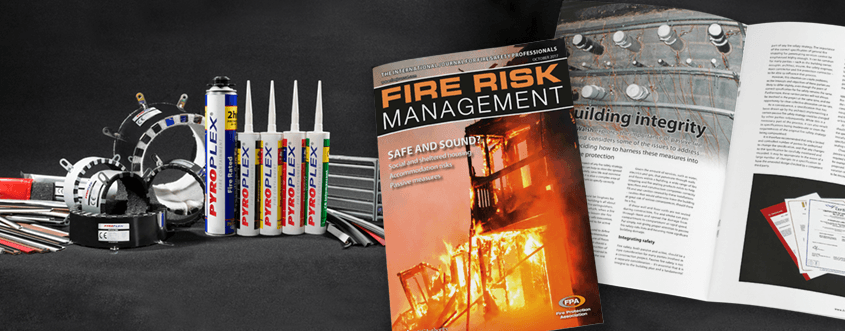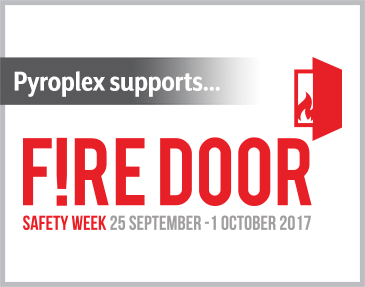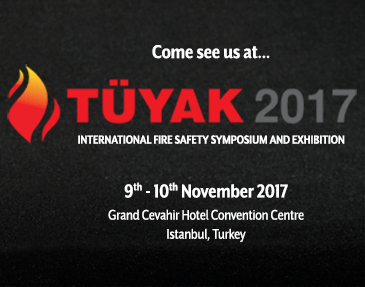Featured in FRM Journal, Andy Walsh, Technical Manager at Pyroplex explains the importance of passive fire safety and considers some of the issues to address when deciding how to harness these measures into your overall fire protection.
An essential aspect of any fire safety strategy, passive fire safety can help to slow the spread of fire and ultimately, save life and minimise damage to property. But it is a complex area of fire safety and most important to specify correctly.
Passive or active?
 It’s not an “either or”. You’d be forgiven for believing that fire safety in a building is all about alarms, sprinkler systems and fire extinguishers. They are all essential components that, when a fire breaks out, can actively help to lessen the fire risk, slow the spread and help to facilitate a safe evacuation. All of the above examples would be considered Active Fire Protection.
It’s not an “either or”. You’d be forgiven for believing that fire safety in a building is all about alarms, sprinkler systems and fire extinguishers. They are all essential components that, when a fire breaks out, can actively help to lessen the fire risk, slow the spread and help to facilitate a safe evacuation. All of the above examples would be considered Active Fire Protection.
The term, Passive Fire Protection is used to define various systems that can help to compartmentalise a building into smaller sections by the use of floors and walls. These systems require no action should a fire break out – they are part of the construction of the building. The fire can more likely be contained in a compartment and not quickly spread to the rest of the building.
Given the amount of services such as water, electrics and gas that penetrate through walls and floors within a building, a wide range of fire stopping and fire sealing products exist to help specifiers and construction companies correctly fill and seal cavities that are created by these installations – cavities that would otherwise leave the building at great risk of dire consequences, should there be a fire.
Without sealing these wall and floor voids during construction, fire and smoke can pass through them and spread the damage from compartment to compartment at great speed. Put simply, not giving proper attention to passive fire safety risks both lives and greater building damage.
Integrate passive fire safety into your plans
Fire safety, both passive and active, should be core considerations for many parties that are involved in a construction project. Passive fire safety is not a separate consideration – it’s essential that it is integral to the building plan and a fundamental part of any fire safety strategy. The importance of correct specification for general fire stopping for penetrating services cannot be stressed highly enough. It can be common for many parties to have the ability to influence this, including the building owner, occupier, architect, insurer, fire safety engineer, main contractor and fire protection contractor.
This situation can create problems as their interests and objectives are likely to differ slightly, even though the point of correct specification for fire safety remains the same. Furthermore, these various parties will not always be involved in the project at the same time and the opportunity for clear collective discussion is rare.
Consequently, a specification drawn up by the architect implementing a certain passive fire safety strategy may subsequently be changed by others. This is a necessary part of the process but there is the potential for specifications to be inadequate or to compromise the requirements of the original fire safety strategy. It is therefore recommended that only a limited and controlled number of parties be authorised to change the specification and that any changes to the specification be carefully monitored and recorded. It may be appropriate in the event of a large number of changes to a specification to have the amended design checked by a competent third party.
Considerations when choosing and installing passive fire safety products

Given the myriad of products available, it may prove difficult to select the most appropriate product to provide the level of fire resistance for the service being protected. To the uninitiated, the cost consideration is usually at the forefront and a principle key driver for selecting the product, coupled with a lack of understanding or knowledge of the installation or application.
Advice should be sought from both the manufacturer and the specialist contractor at the earliest possible opportunity regarding the programming, installation sequence, and suitability before specifying a particular fire-stopping or penetration sealing system.
Choosing the product (or products) is a critical process to ensure that the outcome can achieve the required level of fire resistance. When specifying seals for example, it is often necessary to ensure that the proposed system is capable of accommodating the variation of service sizes and service combinations to be encountered. The ability of any particular sealing system to maintain the performance of a separating element is also dependent upon the material composition, geometry and thermal behaviour of the element being used, from HDPE, PP and other pipe materials such as unplasticised PVCu.
Ongoing management of passive fire safety
Modern commercial and public buildings are dynamic environments in which change is frequent and this can affect the installed fire protection systems. In particular, building services are the principal cause of breaches in fire barriers, e.g. the running of cable when a newly networked computer system is installed. These breaches in fire-resisting elements in the event of a fire may give rise to uncontrolled and rapid spread.
In such dynamic environments, changes are frequently carried out to the internal building fabric, with the introduction of new cables or penetrations. Such additional services can often be undertaken by sub-contractors who were not necessarily involved in the original installation and therefore might not be aware of the requirements in terms of fire stopping. More concerning still, they might have little or no knowledge of the passive fire safety strategy for the building. Additional services passing through the structure during this phase could potentially invalid the fire resistance period and could exceed the loading capability as per the tested solution.
Therefore, it is the responsibility of the competent person to ensure that the proposed contractor is suitability qualified to undertake the works to ensure that any additional services being introduced are done so in a safe and effective manner without compromising the integrity of the fire safety element.
It is certainly good practice to inspect frequently to ensure that inappropriate, unauthorised modifications have not been made. Where modification occurs for the addition or removal of services, the fire penetration seal must be reinstated within the permitted field of application of the sealing system.
The use of any passive fire safety product can be undermined by poor application. Any work that is not of the correct quality could lead to a premature failure of a building compartment in the event of a fire. This in turn could threaten the lives of the occupants and attending firefighters. Thus, it is imperative that contractors with the appropriate credentials for the work install fire-stopping and penetration seal products in accordance with the manufacturers’ instructions.
The importance of third party certification

The fundamental benefit of any third-party scheme is focused around giving the regulator, specifier, customer and end-user confidence regarding the stated performance of the product, providing an informed choice when purchasing or selecting such components in the first place.
Choosing a product that carries the mark of a reputable third-party certification body gives assurances as to the overall performance and effectiveness of that product. Using correctly installed certificated products provides a powerful demonstration that due diligences have been served.
Expert advice and guidance for specifiers and contractors

Pyroplex is an active member of the ASFP. As the UK’s leading trade association relating to ‘built-in’ fire protection, the ASFP is dedicated to the protection of life, property, the environment and our heritage and promotes continuous improvement in all aspects of passive fire protection. It is a valuable resource for installers and specifiers to make use of.
Working with Government and international standard setting bodies both directly, and via other sector group associations, the ASFP endeavours to increase the quality of installed fire protection within all forms of construction.
The ASFP strives to promote excellence in the design and installation of fire protection products through high quality and technical expertise, by fostering the education and training of all those involved in the development, specification and use of ‘built-in’ passive fire protection.
Both the membership of the ASFP and its remit have broadened in response to the significant changes and challenges that are taking place at many levels within the built environment in terms of technical innovation, regulatory direction, the changing political dimension, evolving commercial forces and geographic expansion of the industry. In so doing, the Association is either responsible for or has had a significant input into the vast majority of guidance documents and standards that exist today across the whole spectrum of the passive fire protection sector.
With many invaluable and educational documents made freely available via the ASFP website and with specialist manufacturers such as Pyroplex working with leading organisations to deliver tangible test results and authoritative guidance, specifiers and installers need to embrace these resources and expertise to facilitate the very best fire protection that can be offered – even in the most complex of construction projects.
- Fire-safe building - 21st August 2018
- How to incorporate certified passive fire protection for a safer build - 18th June 2018
- Why Passive Fire Protection is Key to the Construction Plan - 12th June 2018



